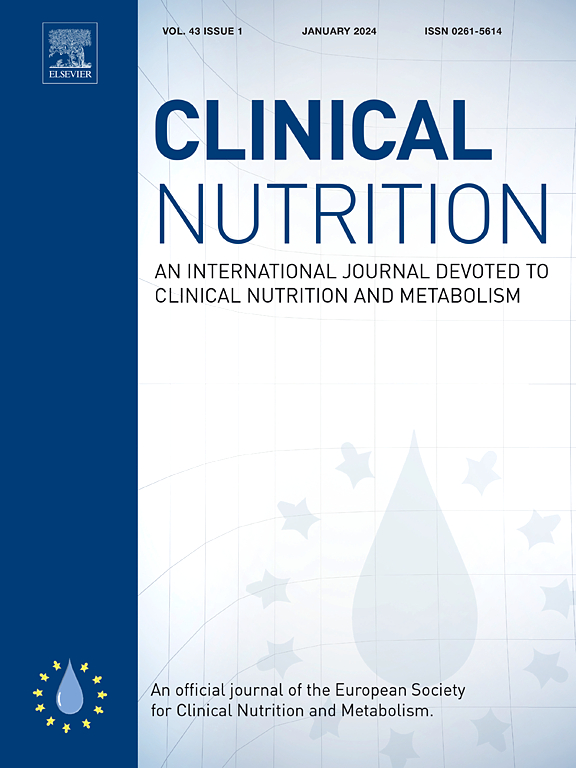食用鱼和海产品与过敏性鼻炎:一项多中心病例对照研究
IF 6.6
2区 医学
Q1 NUTRITION & DIETETICS
引用次数: 0
摘要
背景:过敏性疾病与摄入鱼源性蛋白质和脂肪酸的关系尚不清楚,研究显示出不同的结果。我们的目的是研究这些营养素与变应性鼻炎(AR)发生的关系。方法采用多中心病例对照研究,选取AR病例411例,对照组477例。使用多变量logistic回归模型估计AR的校正优势比(OR)及其95%置信区间(CI)。按鱼类种类和常量营养素进行分层分析。结果食用蓝鱼(金枪鱼除外)与AR几率显著降低相关(每周1份:OR = 0.46;95%置信区间:0.27—-0.80;每周2份:OR = 0.30;95%置信区间:0.17—-0.54;每周3-4份:OR = 0.38;95%置信区间:0.20—-0.68)。相反,与不摄入相比,食用白鱼的人患AR的几率更高(每周3份:OR = 5.49;95%置信区间:3.27—-9.24)。较高的n-6/n-3多不饱和脂肪酸(PUFAs)比率与较高的AR几率相关(OR = 1.79;95%置信区间:1.03-3.13即最高摄取量与最低摄取量的对比)。大量摄入n-3 PUFAs与AR的几率显著降低相关,范围在46%至58%之间(硬脂酸OR = 0.42;95%置信区间:0.24—-0.74;二十碳五烯酸OR = 0.45;95%置信区间:0.25—-0.80;二十二碳五烯酸OR = 0.54;95%置信区间:0.31—-0.96)。结论高摄取量的蓝鱼(金枪鱼除外)与AR发生率低相关,而高摄取量的白鱼与AR发生率相反。本文章由计算机程序翻译,如有差异,请以英文原文为准。
Fish and sea products consumption and allergic rhinitis: A multicenter case–control study
Background
The association of allergic diseases with the intake of fish-derived proteins and fatty acids remains unclear, with studies showing divergent results. We aimed to examine the association of those nutrients with the occurrence of allergic rhinitis (AR).
Methods
A multicenter case–control study was conducted with 411 AR cases and 477 controls. Adjusted odds ratios (OR) of AR and their 95 % confidence intervals (CI) were estimated using multivariate logistic regression models. Stratified analyses by fish type and macronutrient were undertaken.
Results
Blue fish consumption, except tuna, is associated with an important decrease in the odds of AR (1 serving/week: OR = 0.46; 95%CI: 0.27–0.80; 2 servings/week: OR = 0.30; 95%CI: 0.17–0.54; 3–4 servings/week: OR = 0.38; 95%CI: 0.20–0.68). Conversely, compared to no intake, white fish consumption is associated with higher odds of AR (3 servings/week: OR = 5.49; 95%CI: 3.27–9.24).
A high n-6/n-3 polyunsaturated fatty acids (PUFAs) ratio is associated with higher odds of AR (OR = 1.79; 95%CI: 1.03–3.13 for the highest intake level compared to the lowest). High intake of n-3 PUFAs is associated with substantially lower odds of AR ranging between 46 % and 58 % (stearidonic acid OR = 0.42; 95%CI: 0.24–0.74; eicosapentaenoic acid OR = 0.45; 95%CI: 0.25–0.80; and docosapentaenoic acid OR = 0.54; 95%CI: 0.31–0.96).
Conclusions
A high intake of blue fish, except tuna, is associated with lower odds of AR while that of white fish has an opposite association with the disease occurrence.
求助全文
通过发布文献求助,成功后即可免费获取论文全文。
去求助
来源期刊

Clinical nutrition
医学-营养学
CiteScore
14.10
自引率
6.30%
发文量
356
审稿时长
28 days
期刊介绍:
Clinical Nutrition, the official journal of ESPEN, The European Society for Clinical Nutrition and Metabolism, is an international journal providing essential scientific information on nutritional and metabolic care and the relationship between nutrition and disease both in the setting of basic science and clinical practice. Published bi-monthly, each issue combines original articles and reviews providing an invaluable reference for any specialist concerned with these fields.
 求助内容:
求助内容: 应助结果提醒方式:
应助结果提醒方式:


